Autumn Gallery Tour Spinnerei Leipzig
13.9 – 25.10.2025
Around the beginning of the 2000s, the motivational slogan “Live Laugh Love” (the word order can be changed, if desired) circulated widely in various countries. Interestingly, like other similar mottos, this one also had an effect that was the opposite of its probable intentions: the message was trivialised by repetition, to the point of becoming meaningless. The phrase was used on posters, good luck charms, key rings, and every other imaginable gadget, as a way of encouraging people to enjoy the best that life has to offer. The very fact that the slogan became so well-known makes it legitimate to wonder what motivated people to appropriate it and give it visibility. One might speculate that we feel the need to insistently reify certain concepts when their meaning isn’t realised in reality. I believe that Anna Raczyńska’s ironic and clever play on words for the exhibition title, Live Laugh Labour, is a relevant response. The “intruder” term, labour, is truly the great presence of our time, so dominant that it diminishes the importance of everything else. Work and the economy frame individuals: they define roles and how we are perceived, they influence how we act and think, they serve as a measure for defining values, and, ultimately, they convince us of the need to remain continually active, according to specific norms, as if this alone were proof of the fact that we are alive. This has always been valid to a certain extent, it’s true, but since modernity, a new characteristic has emerged: the disconnect between our actions and the outcome. Labour is hard work that does not reveal its result; we could say it is almost a blind operation. The word, in this sense, fits into Anna Raczyńska’s line of research, which is marked by the dialectical relationship between the biographical and the social, the local and the global, the contingent and history. Through a process of semantic “subversion,” accompanied by the free use of a variety of techniques and materials (combining tradition and new technological possibilities), the artist investigates the problematic nature of some of the recurring symbols and meanings in contemporary society. Unlike the blind approach mentioned above, this is a creative process that combines analytical ability and sensitivity, encouraging the audience to reflect and interpret. This applies to all the works in the current exhibition, which has been conceived as a path of correspondences.
Future Primitive is a wreath of wheat and dried flowers, a reference to the prosperity of nature and rural harvest festivals. But its shape, reminiscent of the euro symbol, calls into question much more: Poland’s recent history, between its communist past and neoliberal orientation, the importance of wheat exports for the country, its membership of the European Union but not of the Economic and Monetary Union, and the growing tensions with Russia. We could say it addresses the complexity of relations between what we call the East and West of the continent. The same symbol recurs, along with many others related to power and well-being, in Yesterday’s Tomorrow. There are three structures whose shape recalls Gothic windows, as well as the panels of a pictorial triptych – a reference to the common Christian roots of the West can be seen. They function as a diaphragm, beyond which a contemporary metropolis appears, represented through a myriad of signs that, in the current mindset, would have to do directly and indirectly with “good living”. The inspiration for the work came mainly from Hieronymus Bosch. In fact it could be seen as a “reinterpretation” of the Flemish master’s Garden of Earthly Delights, or as a translation into contemporary, earthly terms of Eden, Earth and Hell – bearing in mind that in our critical and disorienting age, the reign of financial capitalism, the three dimensions are blurred, and the comfort of the few is often the detriment of the many. This damage is not only material but, with increasing frequency, also psychological. SSRI deals precisely with mental well-being and suffering (the acronym stands for “Selective Serotonin Reuptake Inhibitor” and refers to drugs used mainly as antidepressants). Four aluminium sheets, widely used for non-slip flooring, are arranged vertically, on each of them flowers form one of the letters of the title. The effect is surprising, as the sheets even appear to be wet. The contrast between the cold feel of the aluminium and the warm feel of the petals reflects the conflicting feelings experienced by the artist when spring arrived in Leipzig, when she felt uneasy inside but nevertheless continued to admire the strong life of nature and its blossoms. It seems to me that the exhibition has its ideal centre in the work in which the relationship between the self and the imagination occurs most compellingly; Soft Burden, Hard Shell: Bearing Weight Beyond the Body is a silhouette-armour suspended from above, derived from the artist’s torso. A self-portrait, in a sense, again with a modification, because the belly is that of a pregnant woman. Fertility, as well as being a biological fact, is present here as the ability to care for others. This is a further variation on the work, understood as carework, often associated with the female dimension. The iron armour and the womb appear to clash; I write “appear” because many dichotomies are a revisable legacy of the tradition of thought. This presence/absence calls into question various definitions: strength, weakness, endurance, and acceptance. And it seems to recall one of those “creative” identities that some of the leading post-human thinkers have been hypothesising for some time (think of Rosi Braidotti and Donna Haraway). Identities that, through variety and hybridisation, resist those conceptual restrictions which, although seemingly natural, are in fact historically determined and, very often, limiting.
Matteo Innocenti
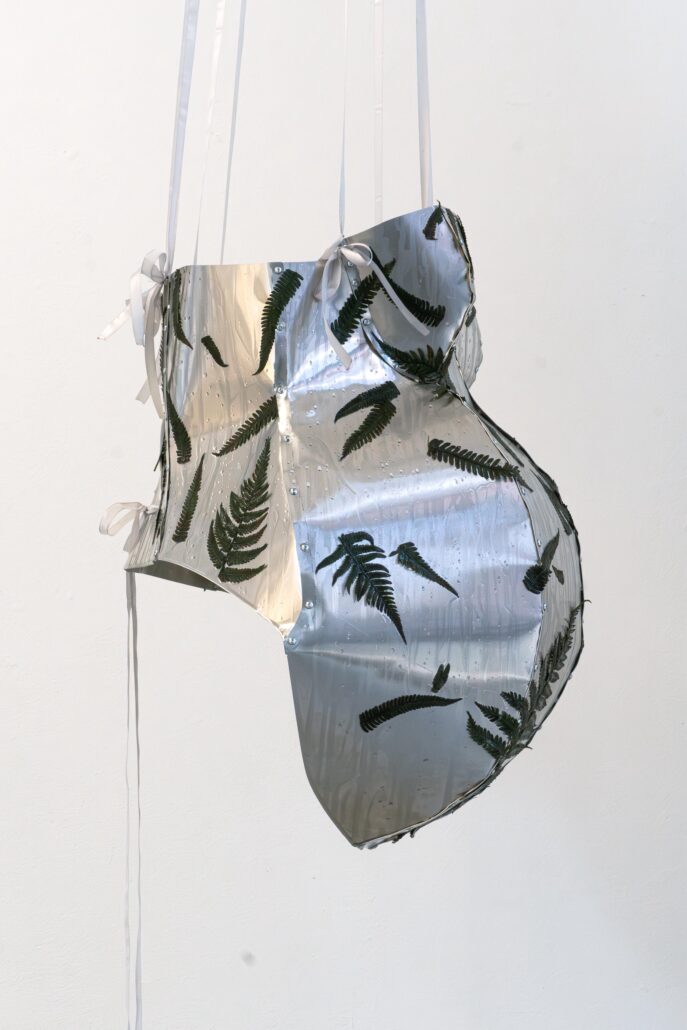
Anna Raczyńska
born 1990, Bielsko-Biała, Poland – lives and works in Leipzig, Germany
Anna Raczyńska is a multidisciplinary visual artist, researcher, and lecturer whose work explores socially relevant themes, particularly the ongoing transformation of Central and Eastern Europe—from the remnants of Soviet-influenced communism to the rise of neoliberal capitalism in mass society. Through her installations, she reflects on tensions such as East vs. West, countryside vs. city, labor and capital, and power dynamics within intersectionality. These themes are reimagined through echoes of Slavic traditions and a critical engagement with the past, filtered through the digital zeitgeist.
Central to her practice is semiotics: she translates spoken and written language into visual form, using pictograms and signs to create striking and direct associations between objects. Her artistic approach spans a wide range of media, including objects, digital prints, 3D animations, sculptures, and immersive installations. Balancing irony with deep material exploration, she transforms everyday objects by reshaping their form, materiality, and scale. Her installations often blur the boundaries between digital and analogue worlds, integrating tools such as laser engraving, 3D modelling, and printing. By juxtaposing contemporary, sterile objects with organic elements of nature, she creates immersive spaces that invite viewers to engage with their surroundings in new and profound ways.
Raczyńska holds an M.F.A. in Sculpture from The Eugeniusz Geppert Academy of Art and Design and a post-graduation in Art and Installation from the Leipzig Academy of Fine Arts. She has exhibited widely in Germany, Poland, England, the Netherlands, and France and participated in international residencies in France, the Netherlands, Slovakia, Bulgaria, and Poland. Her work is included in the Bundeskunstsammlung (Federal Collection of Contemporary Art, Germany), the Cultural Foundation of the Free State of Saxony, and private collections.
Selected Solo Exhibitions: Rewoven Roots, Piana Gallery, Kraków PL 2024 | As the Sun is Sets, Österreichisches Kulturforum, Berlin DE 2023 (with Magdalena Kreinecker) | Yesterday’s Tomorrow, a&o Kunsthalle, Warsaw PL 2023 | FORNEVER, NYG West, Leipzig DE 2022 | Future Primitive, LIA Programme, Spinnerei Leipzig DE 2021 | UNICODE, Kunstenlab / Mondriaan Fonds, Deventer NL 2020 (with Hannes Nienhüser) | 15% of abstraction, Mieszkanie Gepperta, Wrocław PL 2019 | Give me a place to stand vol.2, Progress Gallery, Paris FR 2018
Selected Scholarships & Residencies: Exchange of artistic people between the Piana Gallery Foundation and Kombinat e.V., Leipzig 2024 (supported by the Department of International Cooperation of the City of Leipzig) | stART Artist in Residence, Warsaw PL 2023 | DAAD Scientific Scholarship, Faculty of Fine Arts, Architecture and Design 2019–2021 | Digital Artist Residency OP ENHEIM, Wrocław PL 2020 | Artist in Residence K.A.I.R., Kosice SK 2019 (supported by Goethe-Institut Bratislava) | Artist in Residence La Malterie, Lille FR 2017 (supported by BWA Wroclaw) | ARE Artist in Residence, Enschede NL 2016
Collections: Bundeskunstsammlung (Federal Collection of Contemporary Art, Germany) | Cultural Foundation of the Free State of Saxony | Private collections
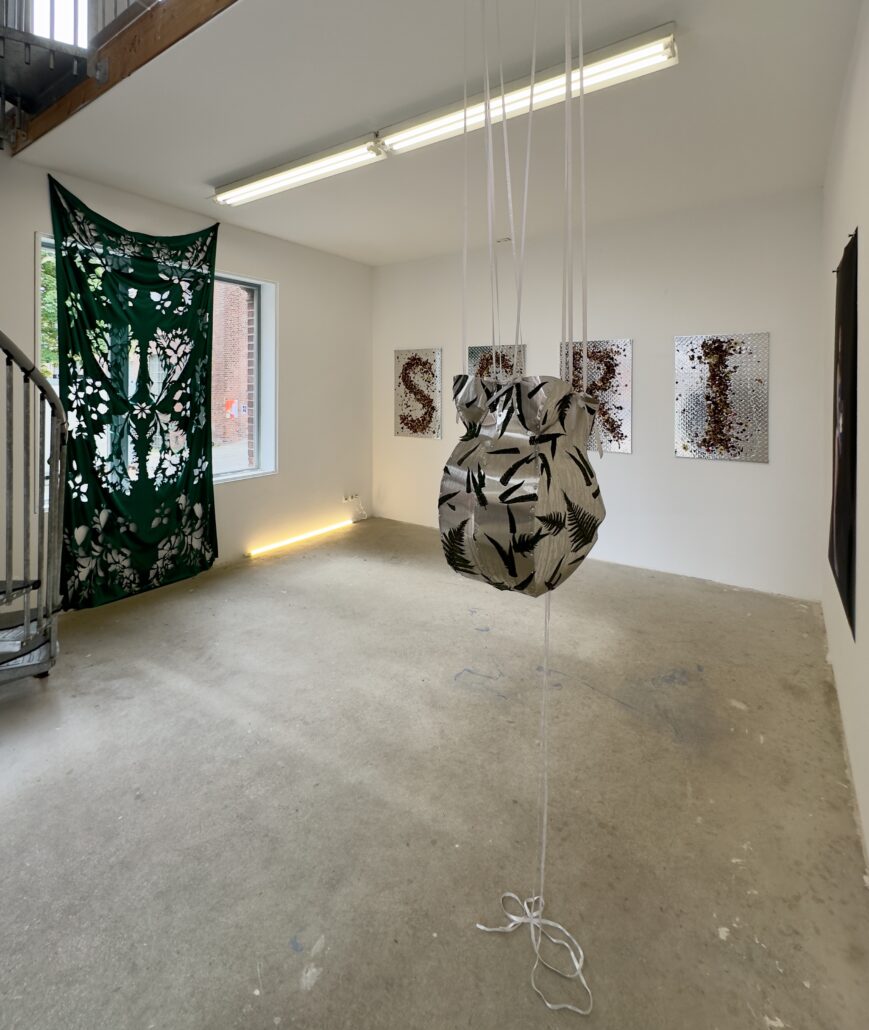
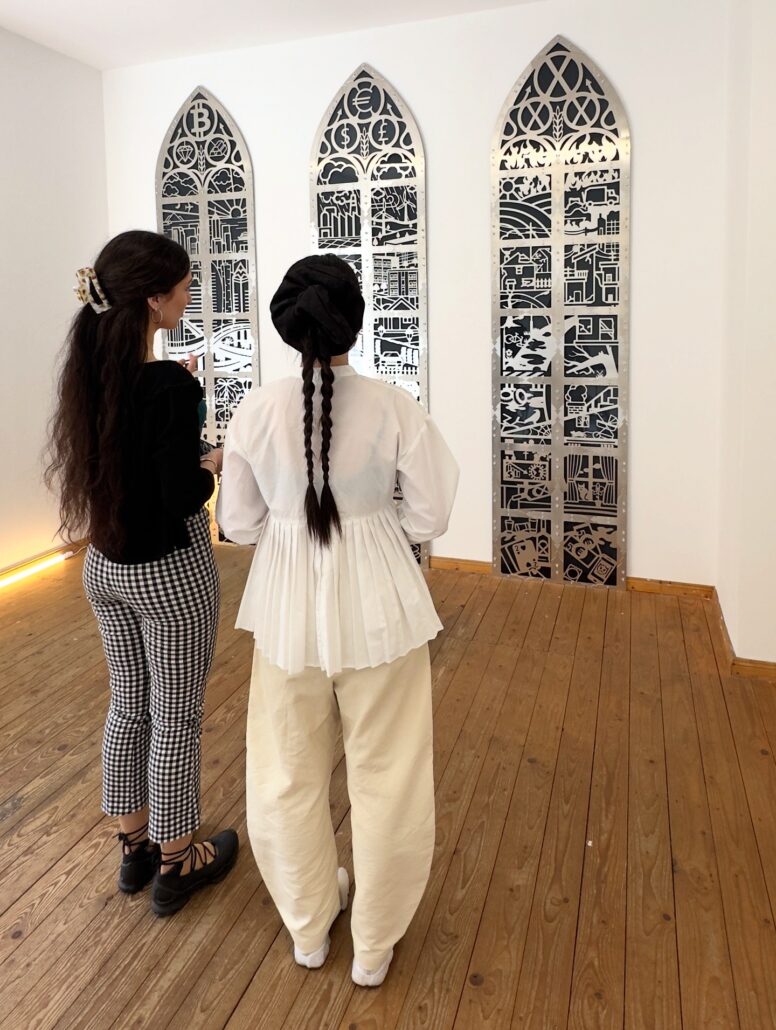
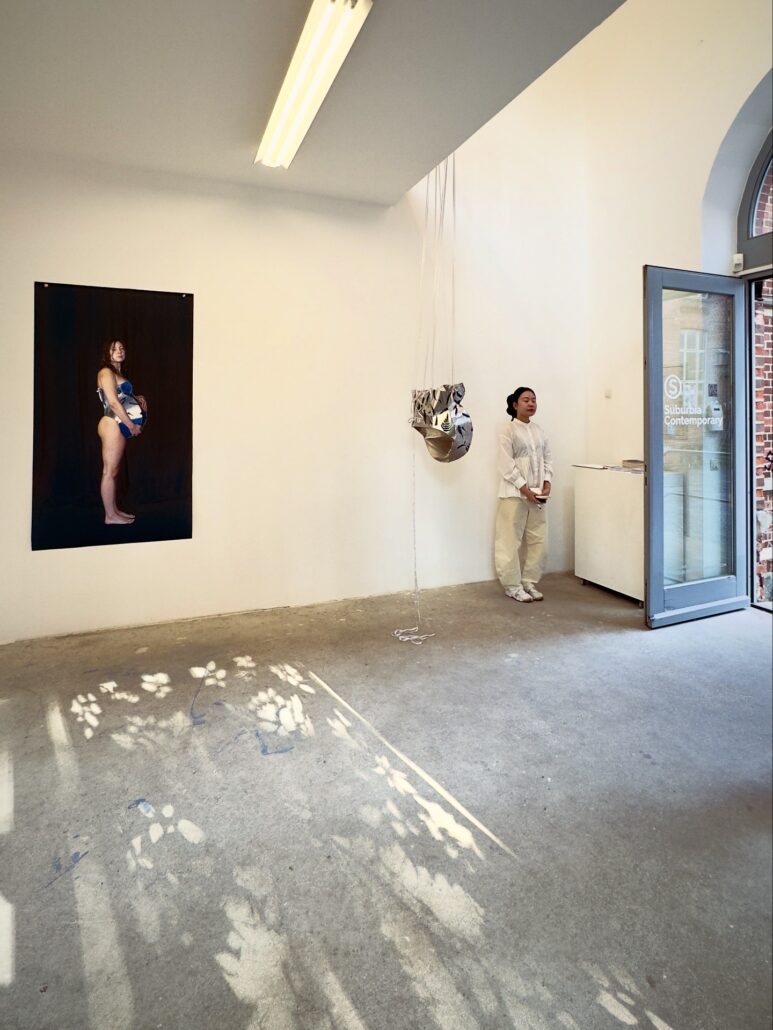
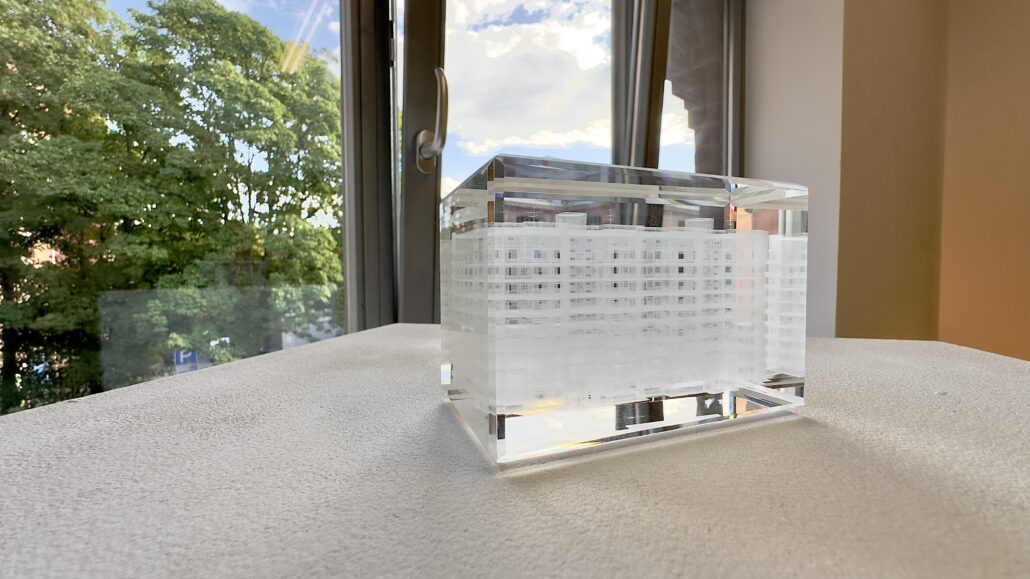
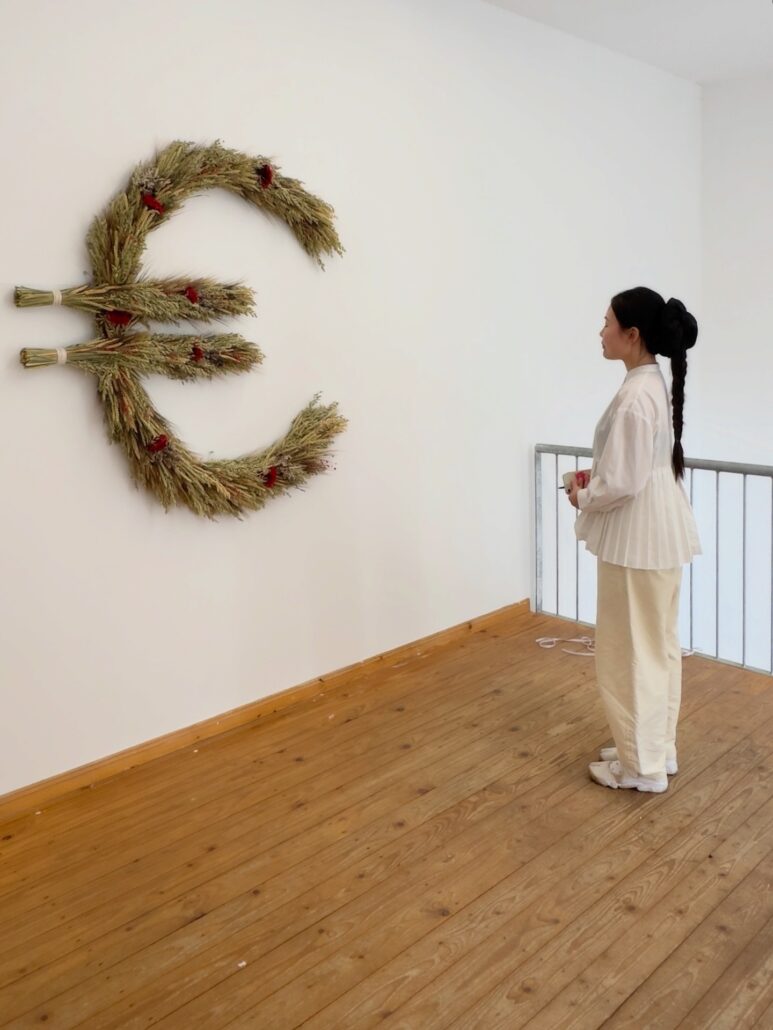
DE
Herbstrundgang Spinnerei Leipzig
13.9 – 25.10.2025
Um die Jahrtausendwende herum verbreitete sich in verschiedenen Ländern der motivierende Slogan „Live Laugh Love“ (die Wortreihenfolge kann nach Belieben geändert werden) weitläufig. Interessanterweise hatte, wie auch andere ähnliche Mottos, dieser Slogan eine Wirkung, die genau das Gegenteil seiner wahrscheinlichen Intention war: Die Botschaft wurde durch Wiederholung trivialisiert, bis sie bedeutungslos wurde. Der Satz wurde auf Postern, Glücksbringern, Schlüsselanhängern und allen erdenklichen Gadgets verwendet, um die Menschen zu ermutigen, das Beste aus dem Leben zu machen. Allein die Tatsache, dass der Slogan so bekannt wurde, lässt die Frage legitim erscheinen, was die Menschen motivierte, ihn zu übernehmen und sichtbar zu machen. Man könnte vermuten, dass wir das Bedürfnis haben, bestimmte Konzepte beharrlich zu vergegenständlichen, wenn ihre Bedeutung in der Realität nicht realisiert wird. Ich glaube, dass Anna Raczyńskas ironisches und cleveres Wortspiel für den Ausstellungstitel, Live Laugh Labour, eine relevante Antwort ist. Der „fremde“ Begriff Labour ist die eigentliche Präsenz unserer Zeit, so dominant, dass er alles andere in den Hintergrund drängt. Arbeit und Wirtschaft rahmen das Individuum: Sie definieren Rollen und wie wir wahrgenommen werden, beeinflussen unser Handeln und Denken, dienen als Maßstab für die Definition von Werten und überzeugen letztlich davon, dass wir kontinuierlich aktiv bleiben müssen, nach bestimmten Normen, als ob dies allein der Beweis dafür wäre, dass wir leben. Dies war immer bis zu einem gewissen Grad gültig, das stimmt, aber seit der Moderne hat sich ein neues Merkmal herausgebildet: die Diskrepanz zwischen unserem Handeln und dem Ergebnis. Arbeit ist harte Arbeit, die ihr Ergebnis nicht offenbart; man könnte sagen, sie ist fast eine blinde Operation. Der Begriff fügt sich in Anna Raczyńskas Forschungslinie ein, die durch die dialektische Beziehung zwischen Biografie und Gesellschaft, Lokalem und Globalem, Zufälligem und Geschichte geprägt ist. Durch einen Prozess der semantischen „Subversion“, begleitet von der freien Nutzung verschiedener Techniken und Materialien (Kombination von Tradition und neuen technologischen Möglichkeiten), untersucht die Künstlerin die problematische Natur einiger wiederkehrender Symbole und Bedeutungen in der zeitgenössischen Gesellschaft. Anders als der oben erwähnte blinde Ansatz ist dies ein kreativer Prozess, der analytische Fähigkeit und Sensibilität verbindet und das Publikum zur Reflexion und Interpretation anregt. Dies gilt für alle Werke der aktuellen Ausstellung, die als ein Pfad von Korrespondenzen konzipiert wurde.
Future Primitive ist ein Kranz aus Weizen und getrockneten Blumen, ein Hinweis auf den Reichtum der Natur und ländliche Erntefeste. Doch seine Form, die an das Euro-Symbol erinnert, wirft weit mehr Fragen auf: Polens jüngere Geschichte zwischen kommunistischer Vergangenheit und neoliberaler Ausrichtung, die Bedeutung von Weizenexporten für das Land, die Mitgliedschaft in der Europäischen Union, jedoch nicht in der Wirtschafts- und Währungsunion, sowie die wachsenden Spannungen mit Russland. Man könnte sagen, dass es die Komplexität der Beziehungen zwischen dem, was wir Ost und West des Kontinents nennen, anspricht. Dasselbe Symbol taucht zusammen mit vielen anderen, die mit Macht und Wohlstand verbunden sind, in Yesterday’s Tomorrow wieder auf. Drei Strukturen erinnern an gotische Fenster sowie an Tafeln eines bildlichen Triptychons – ein Hinweis auf die gemeinsamen christlichen Wurzeln des Westens. Sie fungieren als Diaphragma, hinter dem eine zeitgenössische Metropole erscheint, dargestellt durch unzählige Zeichen, die im heutigen Denken direkt oder indirekt mit „gutem Leben“ zu tun haben. Die Inspiration für das Werk stammt hauptsächlich von Hieronymus Bosch. Tatsächlich könnte es als „Neuinterpretation“ von Boschs Garten der Lüste oder als Übersetzung von Eden, Erde und Hölle in zeitgenössische, irdische Begriffe verstanden werden – in unserer kritischen und desorientierenden Zeit, in der die Herrschaft des Finanzkapitalismus die drei Dimensionen verschwimmen lässt und der Komfort weniger oft zum Nachteil vieler geht. Dieser Schaden ist nicht nur materiell, sondern zunehmend auch psychologisch.
SSRI beschäftigt sich genau mit psychischem Wohlbefinden und Leiden (die Abkürzung steht für „Selective Serotonin Reuptake Inhibitor“ und bezieht sich hauptsächlich auf Antidepressiva). Vier Aluminiumplatten, die häufig für rutschfeste Böden verwendet werden, sind vertikal angeordnet; auf jeder Platte bilden Blumen einen Buchstaben des Titels. Der Effekt ist überraschend, da die Platten sogar nass wirken. Der Kontrast zwischen der kalten Oberfläche des Aluminiums und der warmen Ausstrahlung der Blüten spiegelt die widersprüchlichen Gefühle der Künstlerin wider, als im Frühling in Leipzig ein Unbehagen in ihr aufstieg, sie jedoch weiterhin die Lebenskraft der Natur und ihrer Blüten bewunderte.
Die Ausstellung scheint ihr ideales Zentrum in dem Werk zu haben, in dem die Beziehung zwischen Selbst und Vorstellungskraft am eindringlichsten erfolgt: Soft Burden, Hard Shell: Bearing Weight Beyond the Body ist eine von oben hängende Silhouetten-Rüstung, die aus dem Torso der Künstlerin abgeleitet ist. Eine Art Selbstporträt, wiederum mit einer Modifikation, da der Bauch der einer schwangeren Frau ist. Fruchtbarkeit ist hier, ebenso wie ein biologischer Fakt, die Fähigkeit, für andere zu sorgen. Dies ist eine weitere Variation des Werks, verstanden als Carework, oft mit der weiblichen Dimension verbunden. Eisenrüstung und Gebärmutter scheinen zu kollidieren; ich schreibe „scheinen“, da viele Dichotomien ein überprüfbares Erbe der Denktradition sind. Diese Präsenz/Abwesenheit hinterfragt verschiedene Definitionen: Stärke, Schwäche, Durchhaltevermögen und Akzeptanz. Und es scheint an jene „kreativen“ Identitäten zu erinnern, die einige führende posthumanistische Denker seit einiger Zeit hypothetisieren (denken Sie an Rosi Braidotti und Donna Haraway). Identitäten, die durch Vielfalt und Hybridisierung jenen konzeptionellen Einschränkungen widerstehen, die, obwohl scheinbar natürlich, historisch determiniert und sehr oft begrenzend sind.
Matteo Innocenti
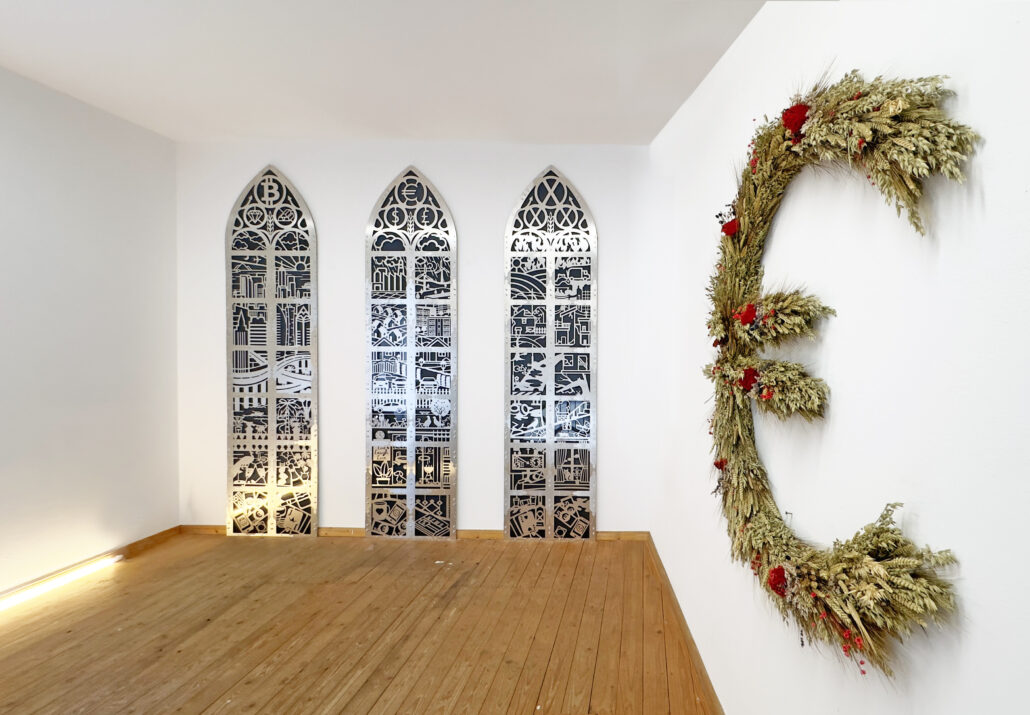
Anna Raczyńska
geboren 1990, Bielsko-Biała, Polen – lebt und arbeitet in Leipzig, Deutschland
Anna Raczyńska ist eine multidisziplinäre Künstlerin, Forscherin und Dozentin, deren Arbeit gesellschaftlich relevante Themen untersucht, insbesondere die fortlaufende Transformation Mitteleuropas und Osteuropas – von den Überresten des sowjetisch geprägten Kommunismus bis hin zum Aufstieg des neoliberalen Kapitalismus. In ihren Installationen reflektiert sie Spannungen wie Ost vs. West, Land vs. Stadt, Arbeit und Kapital sowie Machtverhältnisse innerhalb der Intersektionalität. Diese Themen werden durch Anklänge an slawische Traditionen und eine kritische Auseinandersetzung mit der Vergangenheit neu interpretiert und durch das digitale Zeitbewusstsein gefiltert.
Zentral in ihrer Praxis ist die Semiotik: Gesprochene und geschriebene Sprache wird in visuelle Formen übersetzt, wobei Piktogramme und Zeichen direkte und eindrucksvolle Assoziationen zwischen Objekten schaffen. Ihre künstlerische Arbeit umfasst Objekte, digitale Drucke, 3D-Animationen, Skulpturen und immersive Installationen. Durch die Balance von Ironie und tiefgehender Materialforschung transformiert sie Alltagsobjekte durch Neuformung von Form, Materialität und Maßstab.
Ihre Installationen verwischen oft die Grenzen zwischen digitaler und analoger Welt, indem Werkzeuge wie Lasergravur, 3D-Modellierung und Drucktechnik integriert werden. Durch die Gegenüberstellung zeitgenössischer, steriler Objekte mit organischen Naturelementen schafft sie immersive Räume, die Betrachter*innen zu neuen und intensiven Begegnungen mit ihrer Umgebung einladen.
Raczyńska hat einen M.F.A. in Skulptur von der Eugeniusz-Geppert-Akademie für Kunst und Design und einen Postgraduierten-Abschluss in Kunst und Installation von der Hochschule für Grafik und Buchkunst Leipzig. Sie hat in Deutschland, Polen, England, den Niederlanden und Frankreich ausgestellt und an internationalen Residenzen in Frankreich, den Niederlanden, der Slowakei, Bulgarien und Polen teilgenommen. Ihre Arbeiten befinden sich in der Bundeskunstsammlung, der Kulturstiftung des Freistaates Sachsen und in Privatsammlungen.
Ausgewählte Einzelausstellungen: Rewoven Roots, Piana Gallery, Kraków PL 2024 | As the Sun is Sets, Österreichisches Kulturforum, Berlin DE 2023 (mit Magdalena Kreinecker) | Yesterday’s Tomorrow, a&o Kunsthalle, Warschau PL 2023 | FORNEVER, NYG West, Leipzig DE 2022 | Future Primitive, LIA Programme, Spinnerei Leipzig DE 2021 | UNICODE, Kunstenlab / Mondriaan Fonds, Deventer NL 2020 (mit Hannes Nienhüser) | 15% of abstraction, Mieszkanie Gepperta, Wrocław PL 2019 | Give me a place to stand vol.2, Progress Gallery, Paris FR 2018
Ausgewählte Stipendien & Residenzen: Austausch künstlerischer Personen zwischen Piana Gallery Foundation und Kombinat e.V., Leipzig 2024 (unterstützt durch das Amt für Internationale Kooperation der Stadt Leipzig) | stART Artist in Residence, Warschau PL 2023 | DAAD Wissenschaftsstipendium, Fakultät für Bildende Kunst, Architektur und Design 2019–2021 | Digital Artist Residency OP ENHEIM, Wrocław PL 2020 | Artist in Residence K.A.I.R., Kosice SK 2019 (unterstützt vom Goethe-Institut Bratislava) | Artist in Residence La Malterie, Lille FR 2017 (unterstützt von BWA Wrocław) | ARE Artist in Residence, Enschede NL 2016
Sammlungen: Bundeskunstsammlung | Kulturstiftung des Freistaates Sachsen | Privatsammlungen